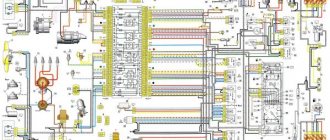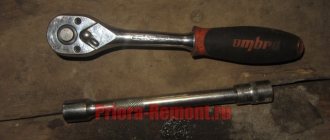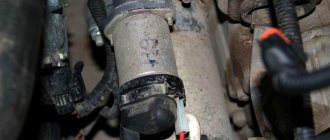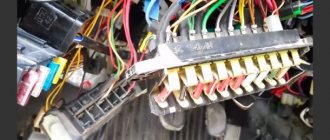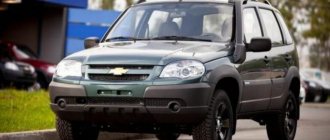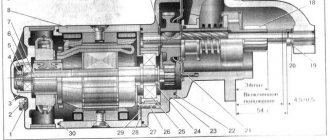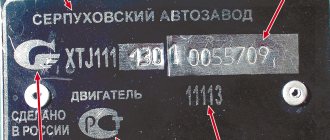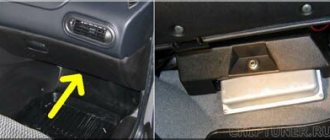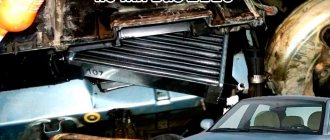Description of problems with the starter and ways to solve them on Niva
On Niva, most of the components are quite reliable and do not require frequent repairs. But there are a number of standard breakdowns characteristic of the vehicle in question. Most often, the starter does not turn for the following reasons:
- turn-to-turn short circuit in the solenoid winding - the relay needs to be replaced;
- open circuit of the power supply - it is necessary to check the connections between connections No. 50 and No. 86 (the most common places of oxidation);
- the relay armature is stuck - it is necessary to replace the armature.
If the solenoid relay is activated, but the starter does not rotate or rotates very slowly, then you must:
- poor contact on the tips and terminals of the battery - it is necessary to stretch it and clean it from deposits;
- the commutator contacts are burnt, the brushes are stuck - you need to clean the commutator and replace the carbon brushes;
- there is a short circuit in the brush holder - it is necessary to replace the cover on the commutator side.
Sometimes it happens that the starter rotates. But the engine flywheel remains motionless. Perhaps the reason lies in clutch slipping. To determine the exact cause and repair, you will need to remove the starter and check it on the stand. The problem can only be solved by replacing the coupling. Sometimes extraneous noise occurs when the starter rotates. The reasons for this may be the following:
- The bearing bushings and armature shaft journals are worn out – the starter needs to be replaced;
- The starter is loose.
To solve most problems that arise during operation, you will need to remove the starter. This procedure may require dismantling the injector. Testing at the stand will not take much time. But it will allow you to determine the exact cause of the malfunction. There is a wide range of breakdowns. They usually occur on cars with mileage of more than several tens of thousands of kilometers.
Starter problems and their elimination
It is worth thinking about replacing the starter if the car owner notices that:
- The plastic on the plastic cover of the relay began to melt; the power contacts easily turn inside the cover.
- Relay coils are damaged.
- When the control wire was removed, the power contacts were not turned off or were turned on in a free order, which resulted in breakage of the spring. Since most solenoid relays cannot be disassembled, it is not possible to inspect the spring.
- The starter does not start spinning the first time, it jams.
- The power contacts are burnt. The voltage at the contacts of the solenoid relay is less than 0.5 Volts.
If severe external defects appear, you cannot do without purchasing a new starter.
If the traction relay clicks and the car does not start, then the culprit of the situation is most often not the starter, but a discharged battery. Its charge is not enough to start the power plant. In addition, the problem may be hidden in oxidized contacts or damaged wires.
This is interesting: How to install lenses in a headlight yourself - useful tips for car owners
The weak point of the unit is the power wire loop connecting the electric motor and the traction relay. It does not connect securely to the terminal and is prone to oxidation and rot. If it breaks, the starter does not turn, despite the fact that a characteristic click of the traction relay is heard from the engine compartment.
To fix the problem, it is recommended to solder a new copper conductor to replace the damaged one. Some car owners resort to welding. To increase the reliability of the unit, some drivers add an additional connection between the relay and the electric motor even before installing a new starter.
The weak link in the electrical circuit of the VAZ 2121 starter is the brushes. They are the most susceptible to wear, so the unit often loses its functionality due to their insufficient length. To determine the remaining life, you need to take out the brushes and measure their size. It must exceed 4 mm.
A large current flows through the brush assembly. This causes heating and thermal destruction of the elements. Upon visual inspection, you can often detect melting of the brushes and the appearance of chips. Minor defects can be eliminated by grinding. In case of serious damage, the brush must be replaced.
Damage to the armature is also found in VAZ 2121 starters. Among the most popular breakdowns is a breakdown of the winding to the housing. The malfunction can be identified by “continuous testing” with a multimeter or ohmmeter. If the specified devices are not available, the breakdown should be checked with a regular lamp. You need to assemble a circuit as shown in the image below. Its ends should be connected to the commutator plate and the armature core. If the light comes on, it means that there is a breakdown in the winding. It is extremely difficult to repair insulation damage, so such an anchor must be replaced.
The collector is also subject to wear. If there is minor damage, the defects can be removed by grinding. If the collector plates are seriously worn or burned out, the armature must be replaced.
Specific problems and methods for solving them
If it is difficult to turn on the VAZ 21214 engine, there is a possibility that the problem lies in the starter. The most common breakdown is that the starter may not turn, even when the ignition is started. Note that the starter relay is located very close to the ignition relay, under the additional. fuse block.
Let's get acquainted with the typical malfunctions of the Niva starter:
BreakdownChecking and diagnosticsHow to get rid of the problem
| The starter solenoid relay is inoperative | There is no clicking sound under the hood when turning the key. If you close the circuit with a handy tool, the starter begins to turn. The starter does not turn when the engine is warm (hot). | Complete replacement of the part (retractor relay). |
| The battery is low. | Despite the click, the starter does not move. When consumers are turned on, the voltage at the battery terminals does not exceed 12V. | Replace/charge the battery. |
| The starter armature winding is damaged and a short circuit has occurred. | To check the serviceability of the mechanism, use an ohmmeter. Also pay attention to places where the insulation has changed color. Darkening indicates problems. | Complete replacement of components (starter). |
| The battery terminals are oxidized and poorly connected. | Even though the starter clicks, it does not turn over. If you turn it on, the voltage at the starter/battery terminals varies greatly. | The contact connections must be thoroughly cleaned, coated with Vaseline or other lubricant, and then tightened tightly. |
| The ground contact is broken, the relay contacts are oxidized. | The starter does not turn even after a click. The car won't start. For diagnostics, it is necessary to measure the resistance in the circuit, as well as the performance of the relay as a whole. | 1) Completely replace the solenoid relay with a new one. 2) Clean the contacts well, lubricate them with a protective compound and tighten tightly. |
| Flywheel ring teeth/drive gear are damaged. | It is enough to conduct a visual inspection of the components to notice a malfunction. | Flywheel replacement, starter replacement or repair. |
| The freewheel slips. | The starter continues to move, but the flywheel remains in place. | Complete replacement of starter/clutch. |
| Rotating the ring gear on the flywheel. | The starter turns, but the flywheel/crankshaft does not. The clutch housing makes unnatural sounds. | Buying a new flywheel and replacing it completely. |
| The starter commutator is burnt, the brushes are very worn/stuck. | Remove the starter and make sure how tightly the commutator is pressed against the brushes. Determine commutator wear and remaining brush height. | If the commutator is worn out as much as possible, the starter will have to be replaced. The damage is minor - just have it repaired or go to a salon. |
| The ignition contacts (50 and 30) cannot close and the solenoid relay wiring is inoperative. | The relay does not operate when the key is turned. The car owner must measure the voltage at the relay control contact. | Replacing the ignition switch, cleaning contacts. |
| Attachments/engine jams. | Visual check of the coolant pump, as well as the crankshaft and power steering pump. | If problems are detected, the attachments/engine itself will need to be repaired. |
This is interesting: Maintenance of Chevrolet Aveo: operating instructions
The starter rotates, but the crankshaft does not turn
If the starter spins, but the engine does not work, then experts recommend checking the condition of the teeth on the flywheel and Bendix gear. During intensive use of the vehicle, critical wear of these teeth is possible. Check their condition through a special mounting hole. You can replace them by purchasing a repair kit for the Niva Chevrolet starter. Its price is about 500 rubles.
A non-working drive unit also exhibits the same symptoms. If the starter gear meshes well with the engine flywheel, but does not rotate, the starter should be checked for wear and other mechanical damage. The node may not be installed correctly.
As for starter repair kits for Chevrolet Niva cars, their configurations and prices can vary greatly. But most often, manufacturers take into account all parts that are subject to wear and need to be replaced.
Selection of components
The original starter is produced by LADA and comes in the original blue packaging. It is marked with article number 21214-3708010-01. The cost of this part is from four to five thousand rubles, depending on the store.
To avoid stumbling upon a fake, carefully examine the box. The presence of extraneous logos, absence of an article number on the box, or color mismatch is unacceptable. The low price should alert you.
Alternative options are produced by companies such as Fenox, Krauf, Valeo. The listed brands are distinguished by high quality products and fairly affordable prices. The price for starters varies from 2200 to 4700 rubles.
What original or analogue can I supply?
If the starter does not turn, you can simply replace it. Typically, in a store, the buyer has a choice between two options:
- original;
- analogue
They differ not only in their quality, but also in their durability. The easiest way to study visual differences is in the photo.
But the cost of the original starter is usually at least 3.5 thousand rubles. That’s why many people opt for analogues. There are many other manufacturers on the Russian market that are not certified by AvtoVAZ. If possible, you should choose well-established brands.
It is important to remember: all starters have different resources and may differ in size. It is advisable to arm yourself with a ruler and tape measure before going to the store. This will allow you to avoid purchasing a device that is not suitable in size. Some manufacturers produce equipment that can be installed on various vehicle models. The price depends significantly on the manufacturer.
Before purchasing an analogue, you need to familiarize yourself with the brand. For example, Bosch has proven itself to be good. The equipment he produces is durable and does not cause difficulties in repair. There is a list of manufacturing companies recommended by AvtoVAZ itself. It is advisable to familiarize yourself with all the nuances and subtleties of installation in advance. This will allow you to select it at the start and install it later yourself.
This is interesting: How Chery Tiggo is repaired and tuned
The car won’t start – we check the main possible problems
The most common occurrence of problems with the engine or electrical system of a car is a lack of ignition. There are different options for the implementation of this breakdown, so you need to know the difference in order to determine the specific unit to blame for the failure to start the engine. The starter may spin, click or be silent, the engine may start and immediately stall, and also make sounds that are unusual for it. It is worth dealing with these manifestations so as not to make the breakdown even more complicated.
Firstly, if the car does not start, you should stop trying to start the engine until the problem is clarified. The timing belt may have broken on the car, and your successive attempts to start the engines will lead to valve failure. Let's look at the main possible manifestations of problems that cause poor engine starting.
Problems with the starter and electrical system of the car
Often the answer to the question of why the car won’t start lies on the surface. Poor performance of the starter or its complete failure is the cause of 80 percent of problems with starting the power unit. Therefore, first of all, check this unit for its correct operation.
Also, starting the engine can be complicated by a dead battery or a broken wire in the car's electrical system. The wire leading from the battery to the starter often breaks, and the car does not respond at all to turning the key in the ignition. Manifestations of problems with the starter are as follows:
In the latter case, the culprit of the problem will be the bendix, which should move out of the starter and turn the engine. This element often wears out and does not perform its tasks. The first types of problems are related to the solenoid relay. Replacing it can often solve this problem.
If your car's battery is dead, the starter will only turn once or twice without starting the engine. Lazy sounds under the hood also mean a dead battery. In all these cases, you can easily start the car from a pusher or with the help of a tow, and in the event of a battery failure, you can light a cigarette from the battery of another car.
Problems when starting the engine related to the power unit system.
Often problems with starting the engine are based on problems with the unit itself, and in this case you need to be much more attentive to extraneous sounds and other possible manifestations of the problem. If the engine knocks during startup, a possible problem is hidden in the piston group or in the valves. The ignition setting may also be lost.
Here everything depends not only on the operating characteristics of the car, but also on the type of engine itself. In some units you can try to find the problem yourself; in the case of modern foreign equipment, you will have to evacuate the car to a service station. The main problems that occur in the engine system and prevent the car from starting are the following:
Also, the car may well not start due to low octane gasoline or poor fuel quality. Diesel engines can be difficult to operate in winter due to possible fuel freezing. The more technology and automatic solutions are present in a car, the more possible problems can be found.
If you understand that the problem of the power unit not starting is not related to the battery or starter, stop trying to start the engine, because you can only make things worse. It is better to invite a specialist or tow the car to a professional station to detect and fix problems.
See what a broken timing belt can lead to on some cars:
Let's sum it up
If your car refuses to start, you shouldn’t torture it with every second attempts to turn the key in the ignition system in an effort not to be late for work. Use the services of a specialist to identify possible problems and get more information about the problem. Then you can easily detect the breakdown and fix it.
If the engine does not start for more serious reasons, the service station will tell you possible ways to fix the problem. It is enough to find specialists who are well versed in your make and model of car. Are there any situations in your driving experience when it was very difficult to determine the reasons for the failure of the power unit to start?
Source
Replacing the starter on a VAZ
The process of replacing the starter is quite simple and can be done at home. You will need a key “13”, as well as a new replacement part:
- If you have an injection engine, remove the generator in advance. The receiver and intake pipe are located close, which can significantly hinder the removal of the starter. Accordingly, the starter can be removed through the lower part of the mechanism.
- The air filter housing must be removed. Then we get rid of the front support bracket connecting the engine mount and the intake pipe. Disconnect the starter heat shield from the engine support bracket and exhaust manifold.
- You can get rid of the upper starter mount using a 13mm wrench. To move the starter forward, you also need to remove the bolts of the lower and middle mountings. Carefully disconnect the traction relay control wire.
- We take the head “13” and get rid of the positive wire of the starter. (See photo). By unscrewing the nut, you can remove the wire and remove the starter. We move it strictly back, along the cylinder block.
Required Tools
In order to remove or install the starter on a VAZ 2121, you need tools, the list of which is presented in the table below. Table - Tools required to replace the front strut
TitleNote
| open-end wrench | "at 13" |
| Head | "at 15" |
| Ratchet | With extension |
| Penetrating lubricant | For example, WD-40 |
| Metal brush and rags | For cleaning fasteners |
Starter replacement process
In order for the replacement of the starter on a VAZ 2121 to be successful, it is recommended to use the step-by-step instructions given below.
- Secure the vehicle by applying the parking brake to the rear wheels.
- To gain access to the place where the starter is located, you must open the hood.
- The starter is located under the exhaust manifold. Use a ratchet with an extension to unscrew the nuts securing the terminals.
- Remove the wires from the stud.
- Remove the bolts that secure the starter to the gearbox, as shown in the photo below.
- Remove the starter from the engine compartment.
- Install the new starter in the reverse order of removal.
Sources
- https://zapchasti.expert/starter/starter-vaz-21213.html
- https://zapchasti.expert/starter/starter-vaz-2121.html
- https://zapchasti.expert/starter/starter-vaz-21214.html
- https://djeeprus.ru/shevrole-niva/elektrooborudovanie/starter-na-nive-shevrole
[collapse]
